Witnessing the northern lights is on almost every traveler’s bucket list. If you catch the aurora at the right time, it’s truly one of the most mesmerizing experiences you could ever imagine. However, there’s a fair amount of research and planning that needs to happen before you can have a successful outing for viewing the lights, so here are several tips for viewing the northern lights.
What are the northern lights (or auroras)?
Auroras are the result of charged particles released from the sun colliding with gaseous particles in the earth’s atmosphere. The different colors produced by them are the product of gases at different altitudes colliding.
The common greenish color is due to low-altitude (60 miles above the Earth) oxygen collisions, while the purple and pink colors are due to collision with nitrogen. Finally, the very rare red auroras come from collisions with oxygen gasses very high in the atmosphere (around 200 miles high).
Auroras occur in both the northern and southern hemisphere but because more people experience them in the north, I believe the “northern lights” label caught on.
Tip: Use the free app WalletFlo to help you travel the world for free by finding the best travel credit cards and promotions!
11-year solar cycle
You don’t have much control over this but the solar cycle is something to be aware of. The sun goes through “solar cycles” about every 11 years when the sun spot activity tends to peak. The more sun spots, the greater the likelihood of a solar storm and the better the chance you have of seeing the northern lights in spectacular fashion. Right now, we are on the down-side of the peak but there’s still plenty of hope to see the lights since solar storms are still happening. The next peak won’t start until we approach 2025!

Location
A big consideration is where in the world are you going to go to view the aurora or northern lights?
To have the best chance of catching the lights you need to find a location inside the “Aurora Belt” (or aurora oval). You can see a representation of the belt in the northern hemisphere below.
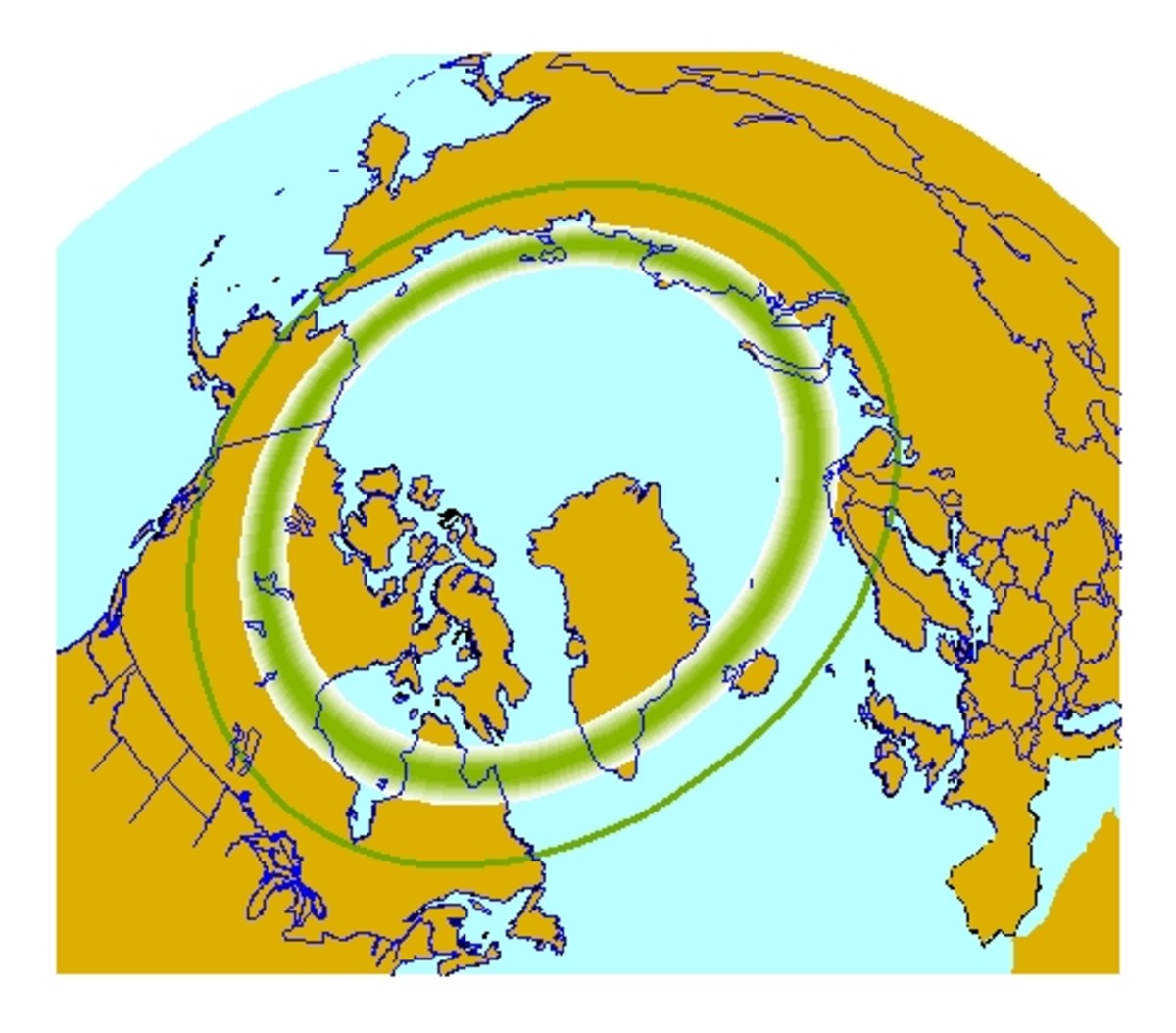
There are four main spots that people flock to within this belt:
- Alaska
- Canada
- Iceland
- and Lapland (northern Norway, Sweden, and Finland).
Of course, you could also venture to harder to reach places like northern Russia/Siberia and Greenland or try your luck with the southern lights, but it seems like most people tend to visit the four places listed above.
I haven’t tried out viewing the northern lights in Canada or Alaska, but I’ve tried them out in Iceland and Norway so I’ll focus on those two destinations.
Iceland
Iceland is great because you can easily find cheap and direct flights to Reykjavik and the country is very small with a main highway that circles around the entire island. This makes it easy to get to and explore from a logistical standpoint.
There’s also plenty of stunning landscapes. From the glacier lagoon to the their seemingly endless number of waterfalls, you’ll find spectacular foreground and backgrounds to view and photograph the northern lights under all over the country.
The drawback is that there’s not a lot of variation in weather on the island since it’s so small.
When I was there, clouds often covered the entire island at once, so there was no way to escape or “hunt” for clear skies (though this isn’t always the case).
The other drawback is that Iceland is almost entirely south of the Arctic Circle, so it may not get quite as much activity as places that are further north and only need a KP index of “0” to see the lights.
Still, Iceland remains one of the top destinations for northern lights hunting.
Norway
Norway, in particular Tromsø, is one of the best places to view the northern lights.
While it requires a little more legwork with connecting flights to get there, it will probably be worth it. Like Iceland, Norway offers tons of stunning coastline and landscape like fjords to view these magnificent lights.
It seems like everywhere you drive in the Tromsø area, there’s another fantastic viewpoint that opens up to a beautiful fjord with snowy mountains overlooking the water (and there’s even a special northern lights highway route).
But I think it’s the micro-climates that make Tromsø such a special and ideal place to view them. The micro-climates are like little pockets where the weather can vary dramatically due to the topography.
For example, it can be completely cloudy and snowing in Tromsø but just 30 minutes away, it might be completely clear. This can be a huge advantage when chasing the northern lights since you’re able to try out multiple places for clear skies. Also, Tromsø is above the Arctic Circle so all you need is a KP Index of zero to see the lights.
I should add that you could consider trips to northern Finland and Sweden to catch the lights, too. I just haven’t visited those places yet (apart from a short drive into Finland), so I can’t really comment on them.
Alaska/Canada
While I’ve never seen the northern lights in Alaska, I know Alaska can be a great place to view them. In fact, the Fairbanks Visitors Bureau says you have an 80 percent chance of seeing them if you stay in Fairbanks for 3 nights. It will probably be colder there than in Iceland or Tromsø, Norway, but colder temperatures may also mean clearer skies.
Alaska also has several national parks known for northern lights spotting and cruise ships offer you the ability to see them as well. And finally, Canada has plenty of places to spot the lights as well. Destinations like Whitehorse and Yellowknife are places you might consider in Canada.
From the sky
One thing a lot of people don’t know is that you can often see the northern lights from a plane when flying through the aurora belt. As long as it’s dark outside, you have a shot at seeing them and since you’ll be flying around 30,000 feet, clouds won’t be an issue.
To see them, you’ll need to block out as much light from the cabin as possible by throwing a jacket or hood over your head and looking at the window. Most passengers will likely be asleep, so who cares if you look a little silly — the northern lights might be outside! Read here about my experience seeing the northern lights from a plane.
Season
This is another big consideration: what is the best time of year to view the northern lights?
Summer
Believe it or not, the northern lights are visible during the summer. In 2016, a solar storm hit in early August and the lights could be seen in places in the northern half of the United States and Canada.
As you might imagine this is a rare occurrence since you have to be at situated lower latitudes to see them and it takes much stronger showings for the lights to make it down to around 50º latitude, so generally don’t count on seeing them during the summer.
And if you’re anywhere near the Arctic Circle, there will be way too much daylight to catch them during the entire summer.
Instead, the vast majority of encounters are going to happen between September and March at the high latitudes, at or above the Arctic Circle. (You can also catch them in late August and some parts of April, too.)
Spring
I personally, think that March is the best month for viewing the northern lights. That’s because it’s near an equinox, which is a time when the northern lights are historically the most active. It’s also a time when the landscape is usually covered in snow — and there’s nothing like capturing a snowy landscape lit up by the northern lights.
There’s also enough daylight at that time of year to enjoy other Arctic activities like hiking, dog sledding, whale watching, etc., so you can count on doing much more than just chasing the northern lights. Thus, I would aim for February or March if I could choose anytime to view them.
Fall
The time near the fall equinox (September and even through October) should see the lights becoming very active as well. However, you typically won’t have snow and might instead have to deal with rain or bad weather during that time.
The big draw to this time of year is that temperatures may prove to be very mild. I’ve heard of people watching the northern lights in Norway (above the Arctic Circle) with t-shirts on and not having to deal with the cold, which would be a more comfortable experience.
Milder temperatures also mean camping is more practical and camping is a great way to get away from light pollution and venture into interesting landscapes that will make for great photographs.
Winter
Finally, winter is a great time due to the fact that you have so much darkness. On Christmas of 2016, we saw a brilliant display of lights around 6pm, which probably would not have been visible during other months. The winter also offers colder nights when there’s less moisture in the air so you might increase your chances of having clear nights and better visibility for viewing the lights.
And finally, there’s just something special about viewing the lights in winter. We witnessed one of the best displays of northern lights I’d ever seen on Christmas night and it it’s one of my favorite travel memories of all time.
Duration of stay
I suggest trying to stay for at least four nights when trying to view the northern lights.
Many of the places that you’ll go like Iceland, Norway, etc., have a lot of other activities to do besides chase the lights so you should be able to find plenty of things to do. Some like to give themselves longer than four nights and prefer to stay for a week or longer, but that’s your choice.
I generally wouldn’t recommend doing a “weekend trip” to see the lights, however, unless you knew there would be clear skies and a solar storm arriving shortly.
Moon phase
Try to plan your visit when there is a new moon or partial moon. They key is to try to avoid full moons or near full moons since the moon can sometimes be so bright that it makes it more difficult to view the northern lights and can detract from photographs.
Time of night
The northern lights are said to be most active from 11pm to 2am, although this can vary slightly depending on exactly where you are and what time of year it is. Still, as just mentioned we saw the lights come out as early as 6:30pm, so I believe that anytime there is a sufficiently dark sky you might be able to see the lights.
Since these are the most active times, be prepared to stay up late or all night to view the lights. If you’re flying to Europe from North America, jet-lag can actually work to your advantage because you can more or less stick to your same sleeping schedule in some instances.
Light Pollution
Light pollution will diminish your ability to see the northern lights. The good news is that in most Arctic areas, it’s not hard to get away from light pollution since there’s a lot of open landscape away from cities.
Getting away from light pollution will help you see the northern lights but it will also greatly improve your photographs. Even a little bit of light pollution from a small town nearby can interfere with your shots by creating an amber glow as seen below, so always try to find a truly dark place.
Cloud coverage
For the most part, you want to hope for as clear of a night as possible. But you don’t need fully clear skies where you can see every little star in the universe.
That’s because the northern lights can often be seen through high altitude clouds.
And second, cloudy skies are often dynamic and if you stay in the same spot long enough, you’ll likely see the sky open up enough to see the lights like in the photo below.
Also, clouds can offer a lot of drama to your photographs. Some of my favorite northern light photographs had a fair amount of clouds in the composition. Sometimes the clouds help to create a slightly ominous green glow in the sky which can be really interesting to capture, too.
Northern light forecasts
It takes the sun 27-28 days to make a full a rotation. Thus, it’s often said that if you experience a lot of activity one day then you might be able to expect a lot of activity around 27-28 days later when the sun makes a complete rotation and those active sun spots are heading towards the earth.
This actually held true in our case but I’m not sure how often this is the case. Keep in mind that solar flares (or coronal mass ejections, take 1 to 3 days to reach Earth) so forecasts within those time frames can be more reliable.
I used this website for a forecast but you can find others that focus on your location (Alaska, etc.) and there are also different apps you can download (I downloaded “Aurora Forecast“). These forecasts show you the KP Index, which is meant to predict how far south the northern lights can be seen.
I suggest to try not to obsess too much over the KP index. If it shows a solar storm hitting that’s probably a reason to get excited but as others have confirmed, you can’t always rely on the KP Index to accurately predict when the lights will appear. Apparently, we still have a lot to learn about the northern lights.
So just hope for the best and do everything you can to spend at least 4 nights in the aurora belt chasing clear skies and you’ll probably end up seeing them.
Should you do a northern lights tour or self-explore?
This is a very common question when it comes to searching for the lights. Some think that northern lights tours are rip-offs and others swear by them.
I think tours are great for places like Norway where it makes sense to sometimes drive a few hours to get to a different micro-climate for better viewing.
Also, if you’re not comfortable driving in Arctic conditions you probably don’t want to venture off on your own so signing up for a tour could be a good thing for your safety.
Some tour companies will allow you to come back the next night for free or at a discounted rate if you don’t see any lights the first night, so that’s always something to consider, too.
I think you should consider doing both. After I had such a great experience with the Chasing Lights tour company in Tromsø, Norway, I’m a big fan of going on tours. And after Brad and I had such a successful outing chasing the lights on our own, I enjoyed the freedom offered with doing our own chase. Being able to stop when we wanted, choose our own route, stop to take photographs, etc., was great.
So if you can afford it, I recommend trying out a tour for a night or two and then gauging if you’re comfortable going on your own chase through the night.
Staying warm
Layers
Dressing with layers makes the world of a difference. In general, you want wool thermal underwear and socks to keep you warm under your multiple outer layers. Boots, hand/feet-warmers, gloves (with liners), and beanie are a must. Wind-proof jackets and pants are very useful, too. Exactly how many layers you’ll need will vary depending on the person, but I recommend to always play it conservatively.
If you’re a photographer some kind of water-resistant winter pants will help you if you’re going to be constantly kneeling in the snow (which you might need to do). One reason why tour companies are great is that many will offer you the option of getting a thermal suit and boots, so you don’t have to stress about freezing to death.
The wind makes all the difference
One night we ventured into Finland away from the coast and at an altitude of about 1,500 feet. The wind was nonexistent but the temperature was about -2Fº. That was the coldest temperature I’d ever been exposed to but with no wind, it was completely bearable.
Another night, temperatures were around 30Fº but the winds were strong and swirling and it was much more difficult to contend with the temperature for an extended amount of time (a few hours). Thus, mind the wind conditions and do everything you can to protect yourself.
One way to combat this is to use some type of ski mask in conjunction with a beanie and scarf. For people like myself from the Sun Belt who aren’t experienced with arctic temperatures, it really helps to protect any inch of exposed skin, especially that on your face when outside for an extended period of time.
Watching the lights
The northern lights come in many different forms. The most common form is a green streak or glow in the sky. When the lights are present but weak, this will look like a faint whitish-grey color with a hint of green that could be mistaken for a cloud.
The photo below represents what a weaker streak of the northern lights might look like to the naked eye. It’s honestly not the most impressive thing in the world but keep your eye on it because you never know what it might do. Patience is key.
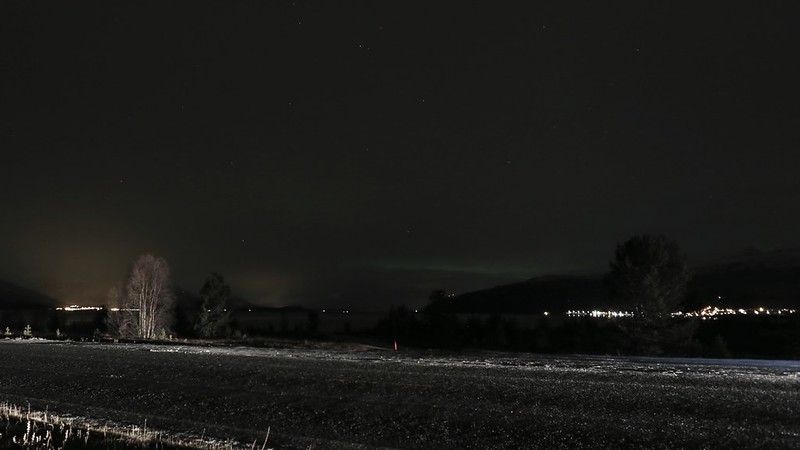
As you continue to wait, you might see those faint streaks intensify. This is when it starts to get exciting. All of a sudden those faint streaks become more and more prominent and their greenish color becomes more apparent. You might see these huge streaks slowly stretch across the entire sky, folding and swirling and constantly morphing into different shapes before your eyes.
One thing I loved about watching the lights is that you’ll be fixated on one area of the sky and then turn your gaze to another part of the sky and be surprised by the sight of more curtains of lights expanding beautifully under the stars. It’s a phenomenal sight to behold.
It’s all about the dancing
But when things get really exciting is when they lights decide to start “dancing.”
The dancing comes in many forms. Sometimes it’s a slow flutter like motion that resembles someone playing a huge lit-up piano in the sky. Other times it’s even more dramatic. Typically, when the dancing occurs the lights become much brighter and the green comes with flashes of white and even pink and purple.
The light ripples and whips fast through the night sky, dazzling every onlooker, and those bursts of light are possibly the most stunning thing you will ever witness. See the video taken by our tour guide below to see what I’m describing.
This is why you need to stay outside or in view of the sky as much as possible. Even going inside for five minutes could cause you to miss a dancing show. The key indicator that dancing is on the way is that you notice a sudden increase in intensity of color or brightness and you’ll also often see many different curtains in the sky. If that happens, be on the lookout because you might getting a show.
Final word
Catching a good showing of the northern lights take a little bit of effort and luck. There are a lot of things outside of your control but by taking the information found in this article into consideration, you’ll be able to set yourself up for an unforgettable night under the aurora.
Daniel Gillaspia is the Founder of UponArriving.com and the credit card app, WalletFlo. He is a former attorney turned travel expert covering destinations along with TSA, airline, and hotel policies. Since 2014, his content has been featured in publications such as National Geographic, Smithsonian Magazine, and CNBC. Read my bio.

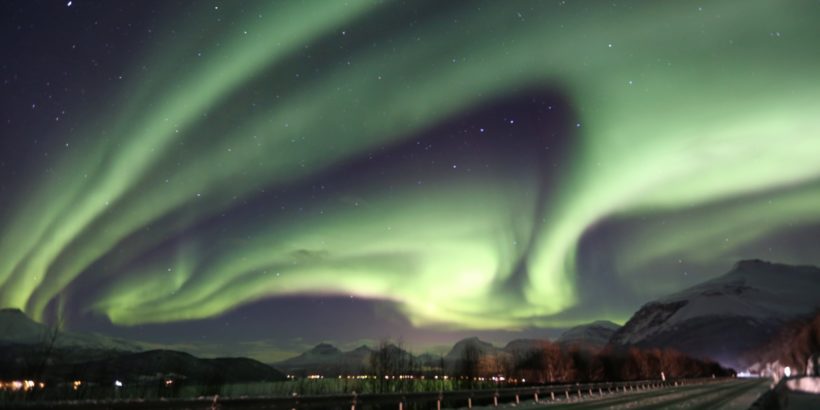

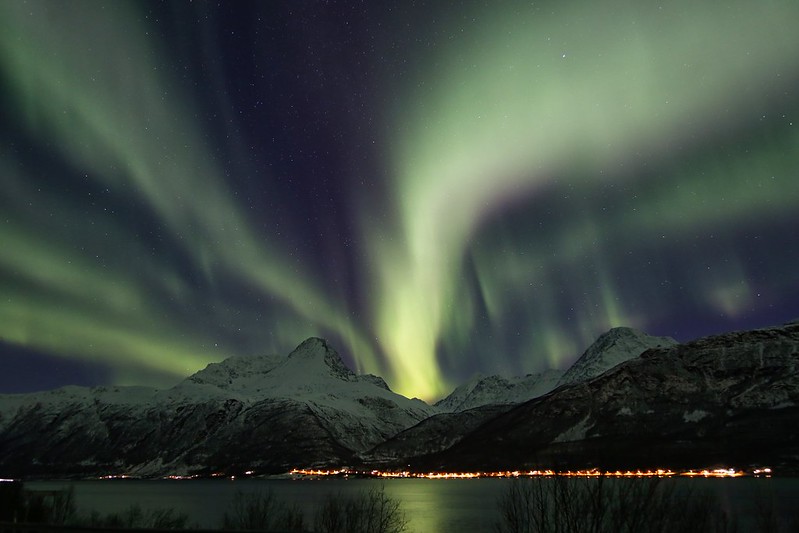
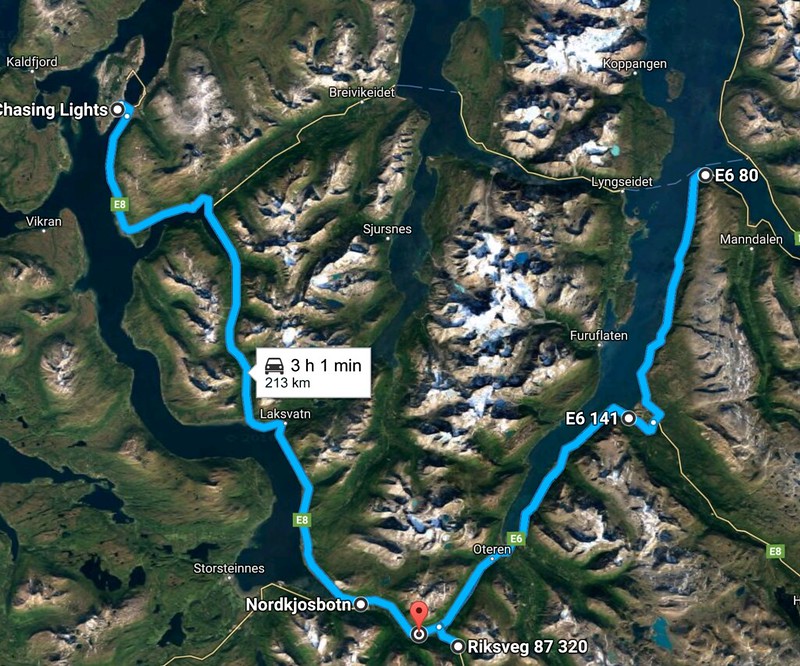
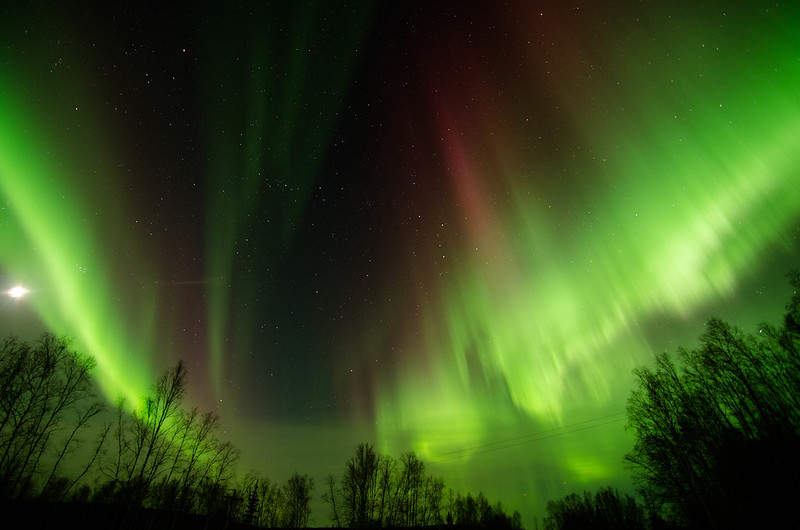
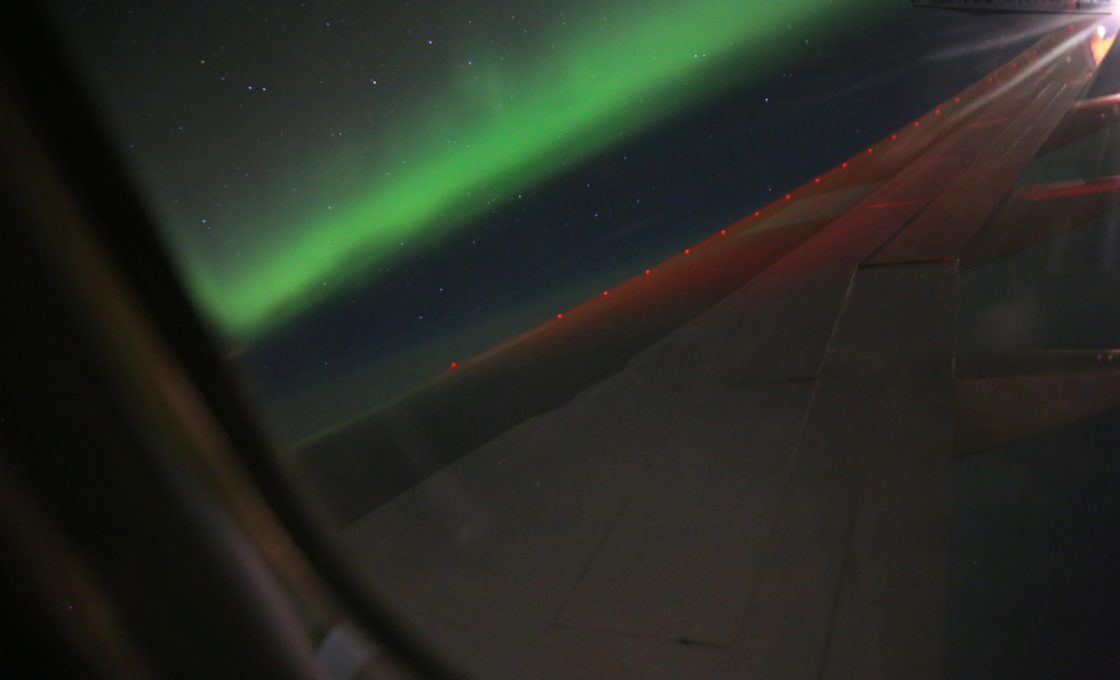
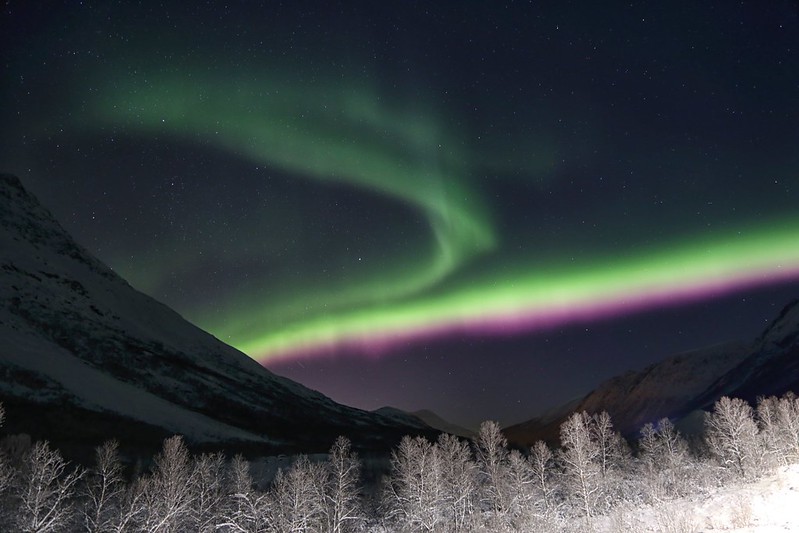
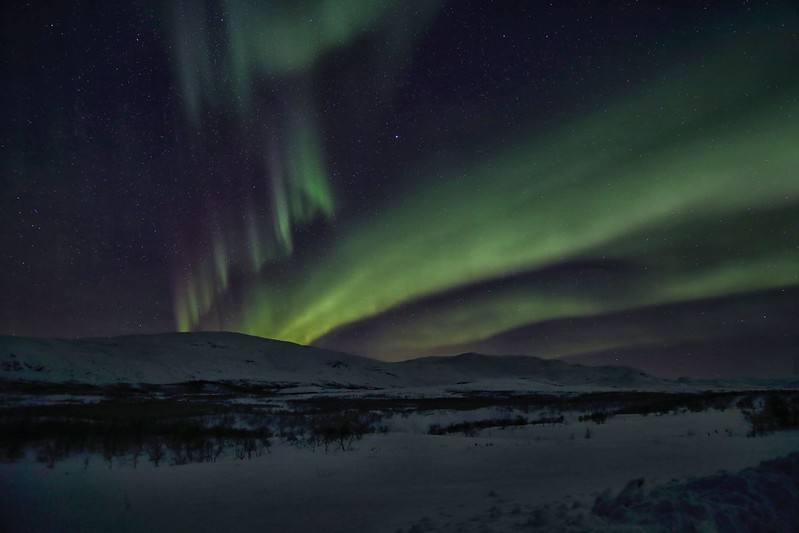
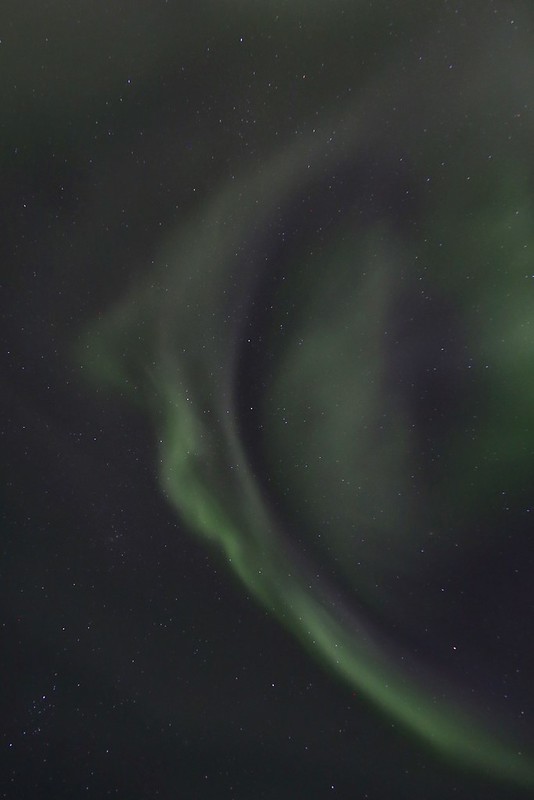
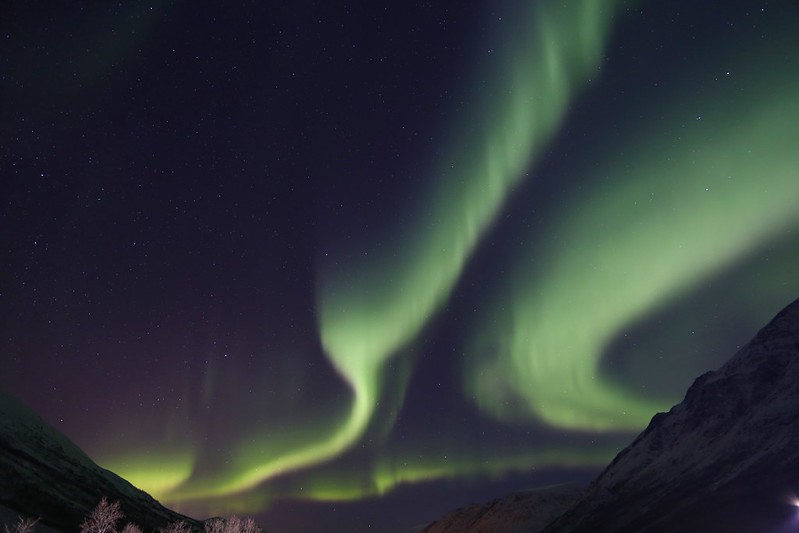
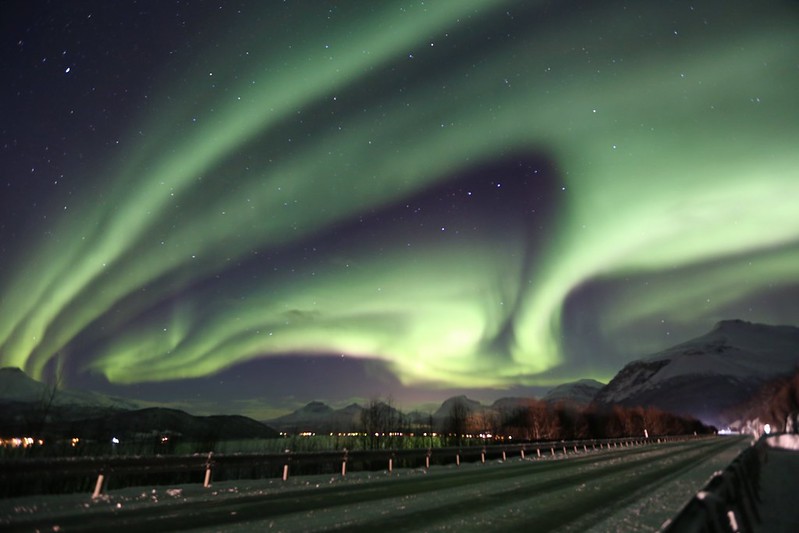
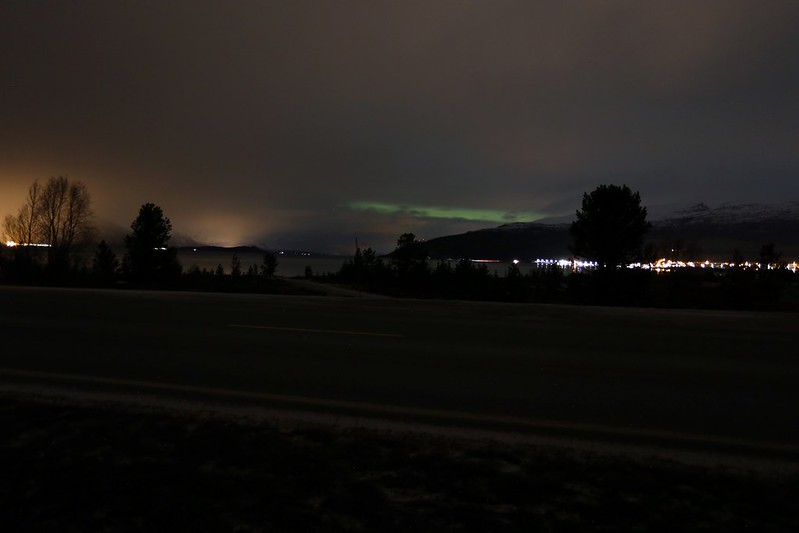
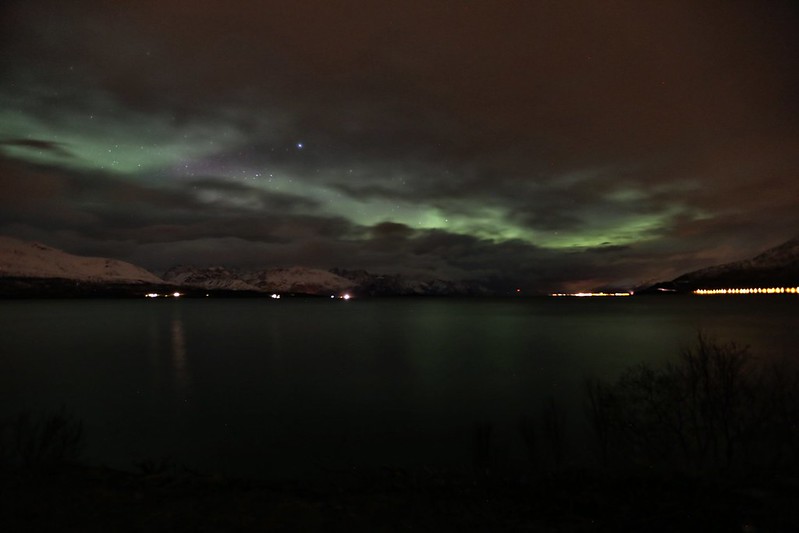
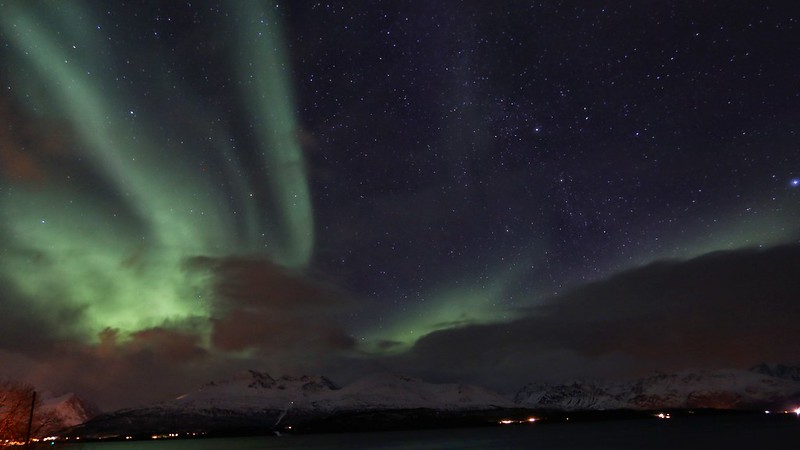
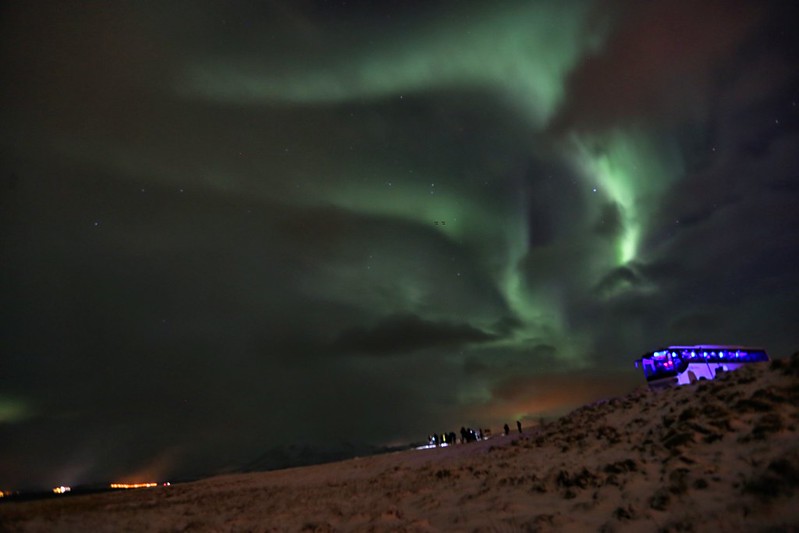
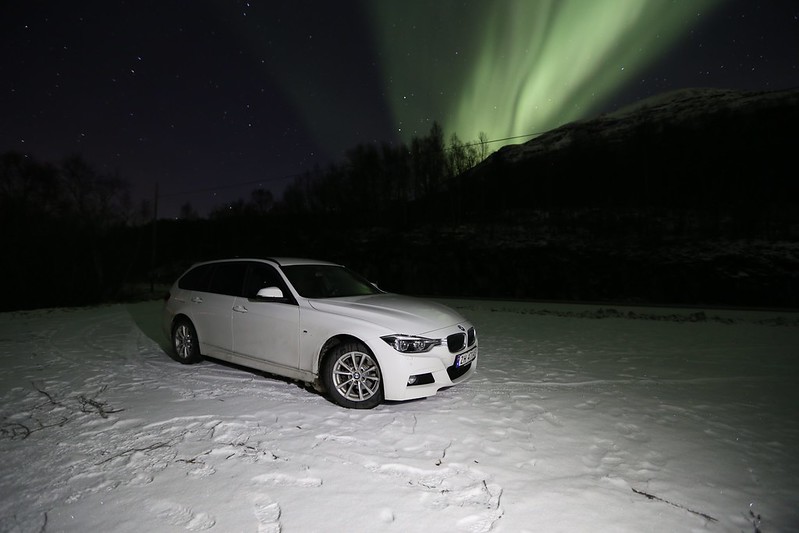
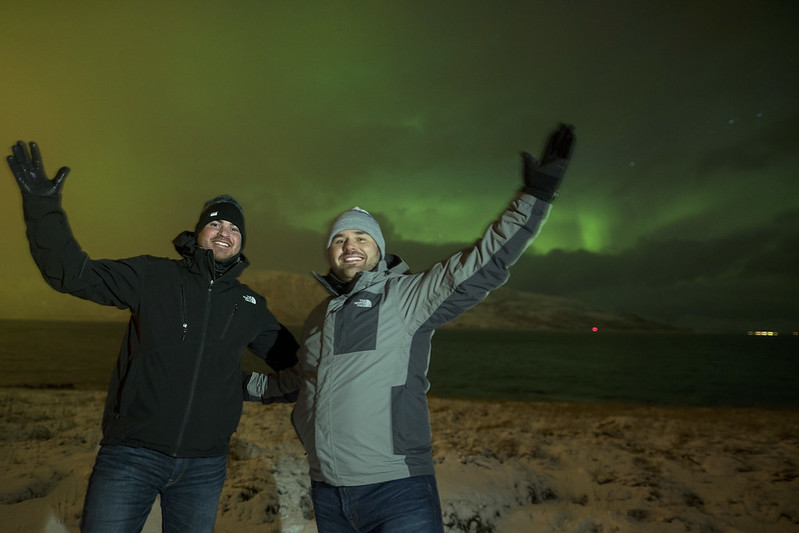
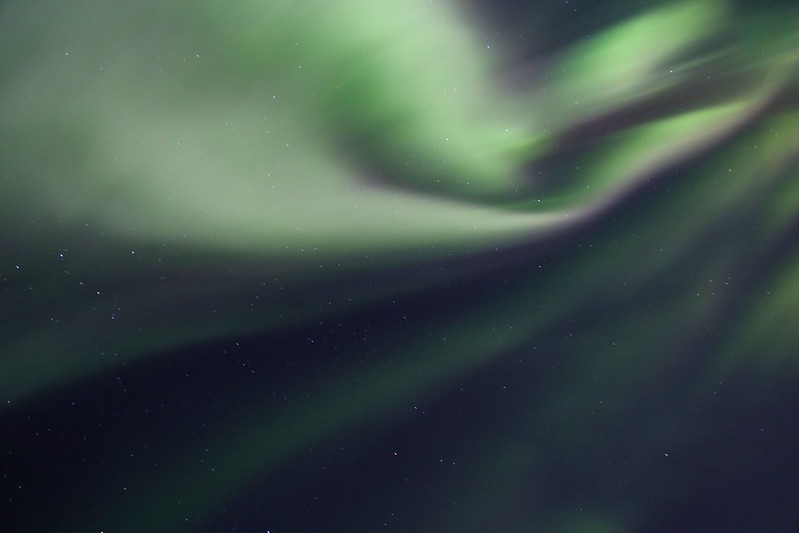
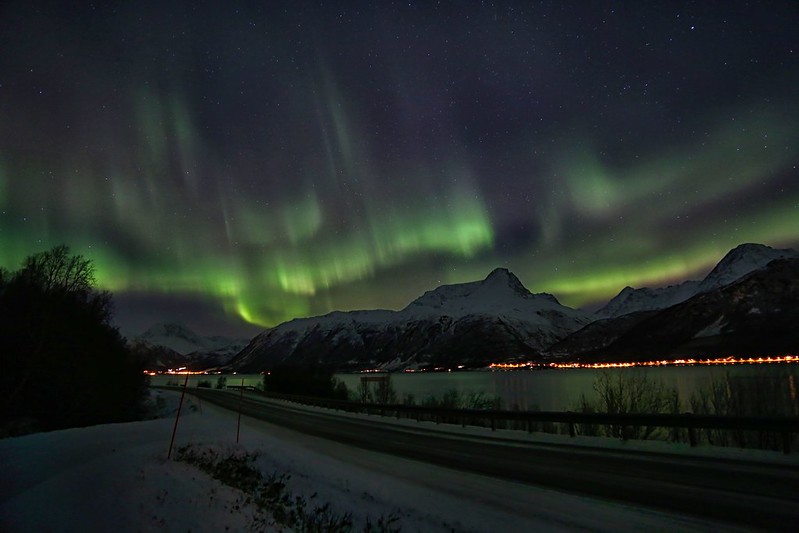
Great article! How did you get to Tromso? I am trying to see if I can book flights using miles and points, specially British airways from Seattle. Any suggestions on the best route and miles & points tips?
Thanks. We used Aeroplan miles to book a 3 segment flight from Houston to Tromsø in business class. We flew from IAH to EWR on United and then SAS to from EWR to OSL and on to TOS. The refurbished business class on the A330 was pretty nice and we got great value from our redemption. Total fees were like $12 for both of us. For such a long-haul flight, I’d try to stay away from using BA Avios in business, but you might be able to put something together in economy that isn’t that bad. Are you interested in flying economy or business class?
Business. What about booking Aerlingus using Avios to Dublin. Then fly into Oslo with BA. Lots of availability from Dublin to Oslo with Avios and small fee. Haven’t tried Aerlingus with Avios yet.
Do you have specific dates or a time frame? Off the top of my head it seems like the new rates with Aer Lingus might be reasonable if you can book off-peak. You’d have to deal with at least 4 segments to get to Tromsø, which is a bit of a pain though.
Thinking around March. Although flexible. Have loots of Avios miles and would like to make good use of them. So hard to use them though. Have been reading about how to best use Avios. I personally haven’t been able to.
Well the entire month of March is off-peak so that’s a good. If you want to fly business consider transferring your Avios to Iberia Avios, since Iberia often offers better rates for business class. I checked and you could fly from Boston to Madrid in business class round trip for 68,000 Avios and around €175 in fees which for Avios isn’t that bad. You could then use Iberia to fly to Stockholm, Sweden, which is serviced by direct flights to Tromsø. That would be an additional 40,000 avios round trip in business. So thats 108,000 Avios right there. You’d still need to cover your segments from SEA and the last leg to Tromsø, though. Flights from Stockholm to Tromsø can be as low as $125 one way on SAS so consider paying out of pocket for those. Flying OneWorld from your location is a bit tricky but definitely look into using Iberia Avios.
Thanks for the tip! Will definitely look into that.
No problem. And just in case you haven’t created an Iberia account, I suggest doing so now because you have to have an account with them for 90 days before you can transfer BA Avios. You can read more about it here: http://frequentmiler.boardingarea.com/2015/12/11/bet-you-didnt-know-3-methods-to-transfer-avios-between-iberia-british-airways/